Here's How a Denmark Based E-Commerce Company Increased Traffic by more than 140% - A SEO Case Study
By: Joseph de Souza
Sometime in January of 2018, the CEO of a Denmark based company met me regarding the company websites which were receiving a small amount of search traffic. They were using a Prestashop multi-store and the site(s) catering to a particular country were mapped on to the appropriate Country Code Top-Level Domain.
The websites had a lot of issues. Some of them were Keyword Cannibalisation (many pages ranking for the same keyword but very low on Search Results Page), lots of problems with technical SEO, wrong redirects, Hreflang issues, Not enough content and improper targeting.
Basically I conducted a technical and On-Page SEO audit, also identified Keyword cannibalisation issues, hreflang issues and revamped the content after extensive keyword research for Home page and 6 pages each in the Danish & English (UK) websites. A large number of technical issues were also corrected.
The sales varies as per season since this is a seasonal business. The SEO work for this company from Denmark was started in February 2018 and completed for this phase in December 2018. Here is an overview of the traffic before starting the work (OCT 2017) and after (OCT 2019) - Please click to enlarge.
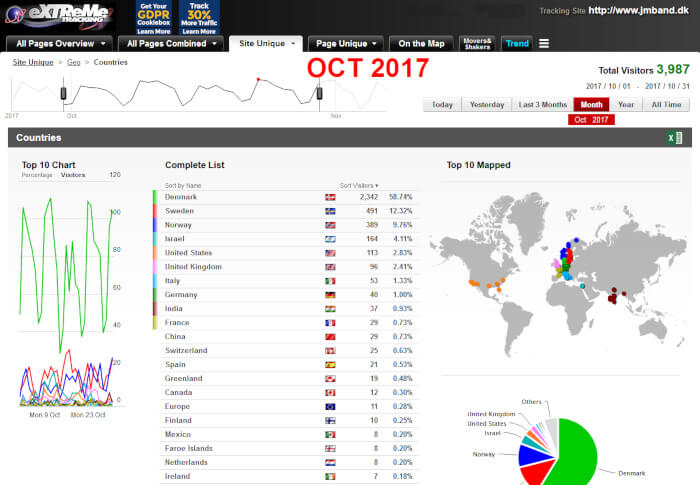
As you can see below the traffic has increased by more than 141%
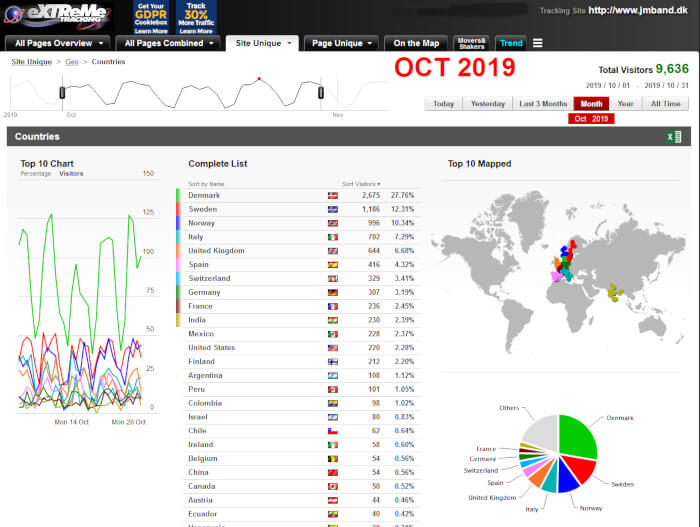
Detailed Keyword Research
Detailed keyword research was done for the home page plus another six pages which included a mix of category pages and product pages representing the company's most important pages. The keywords were fairly competitive. For example see this keyword "papirarmbånd" (paper wristbands)
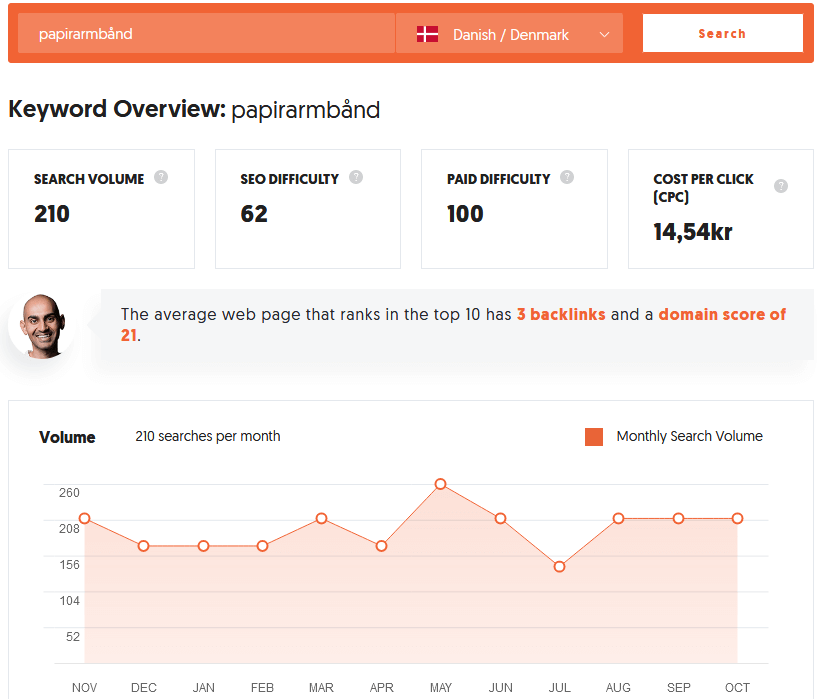
Renaming of products was also done wherever required based on what people search for. For example we changed textile wristbands to fabric wristbands.
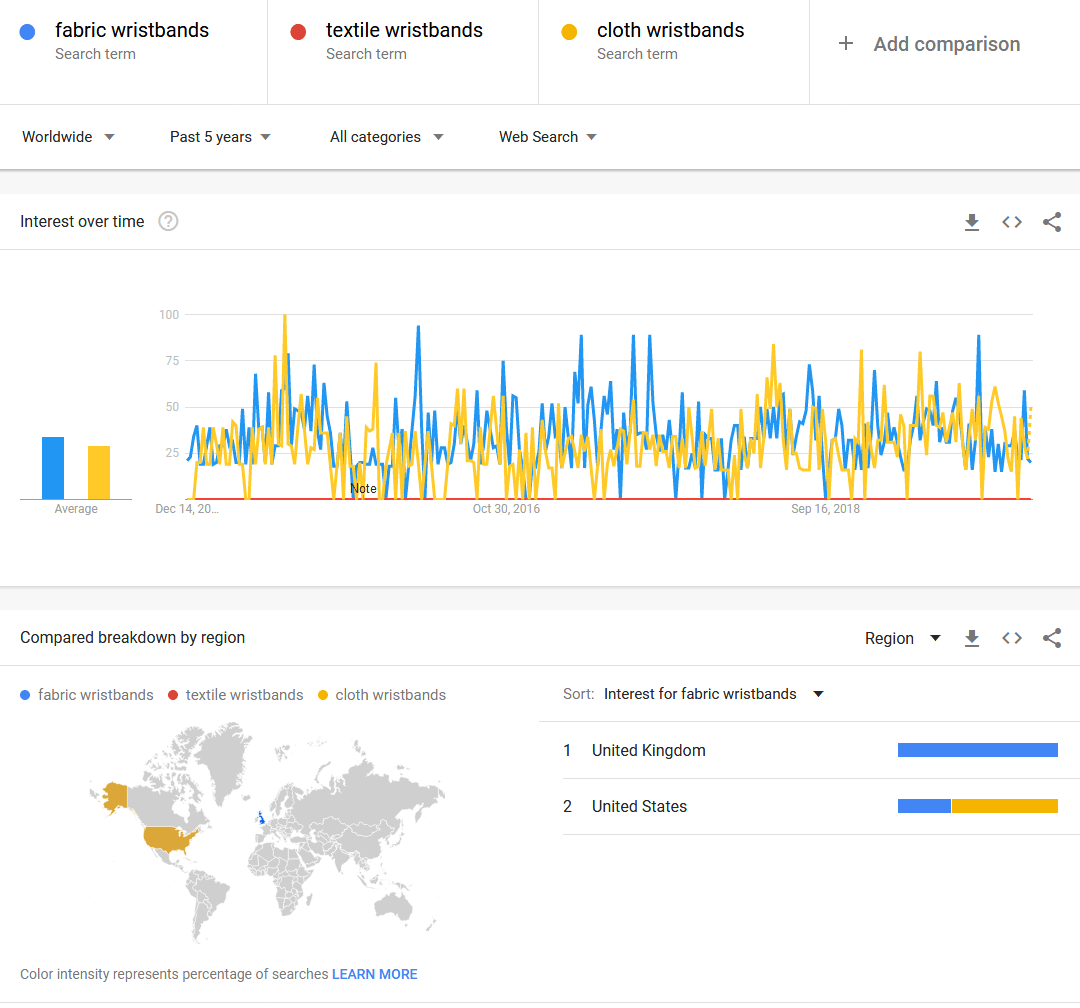
Revising The Content
The content for home page plus another six pages was totally rewritten. The home page content was written by me and the client wrote the content for the other pages. I added the titles, description tags , H tags, checked the targeting of keywords as well as all other On-Page factors.
When translating, we kept in mind localisation of the content and the words people actually use when searching for the products in that particular language. For example "Coloured Paper Wristbands" was translated to "Papirarmbånd Uden Tryk" (paper wristbands without printing)
For example checkout the content revamp on the home page of the UK website. Please click to enlarge and view the entire page
Old Home Page of the UK Website
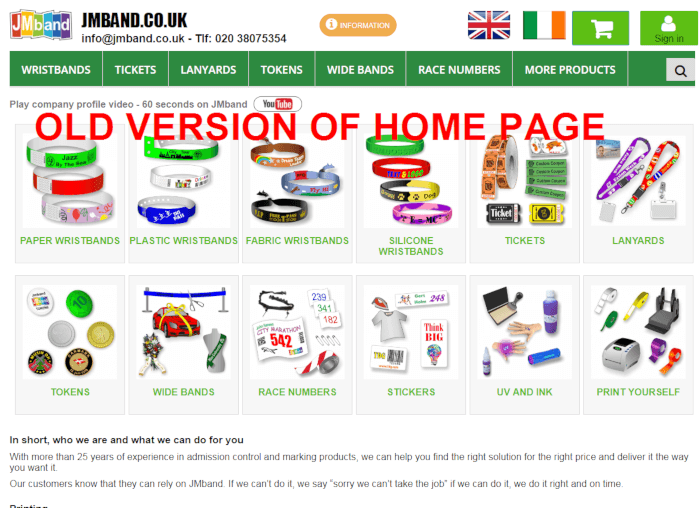
New Home Page of the UK Website
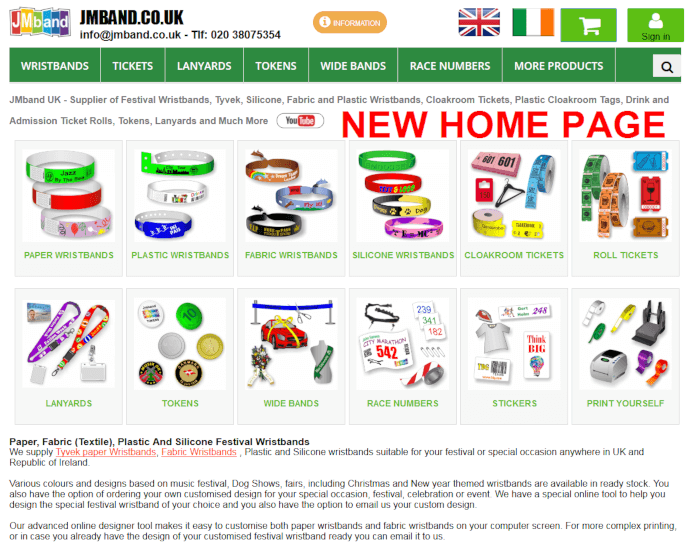
Introduction Video Explaining The Products Supplied
A short video was also produced explaining the products supplied by the company as well a bit about the company. A similar video was produced for the Danish website.
Keyword Cannibalisation Issues
The keyword cannibalisation issues were solved by proper targeting and improvement of content.
This was done after analyzing and targeting head terms in the category pages and specific product related keywords on the product pages and optimising them.
For example see this example of this very important keyword "papirarmbånd"
Before SEO was done 5 pages of the website were appearing in position Four to Eight and after SEO the website appeared in the top spot. Please click to enlarge
Papirarmbånd SERP 2018 - Positions Four to Eight
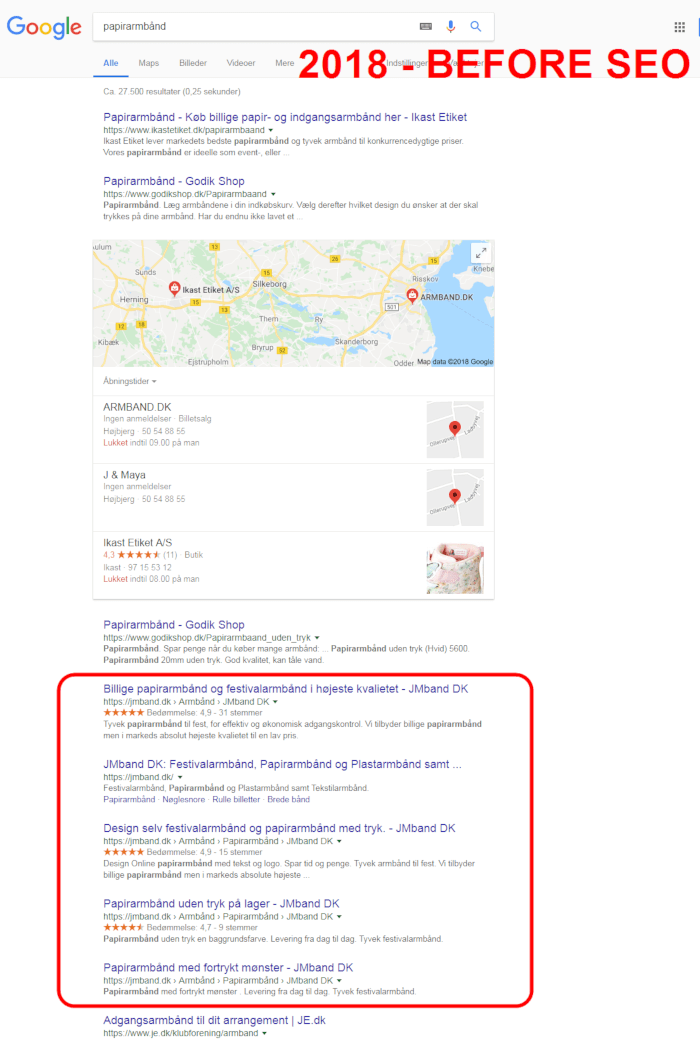
Papirarmbånd SERP 2019 - Position One
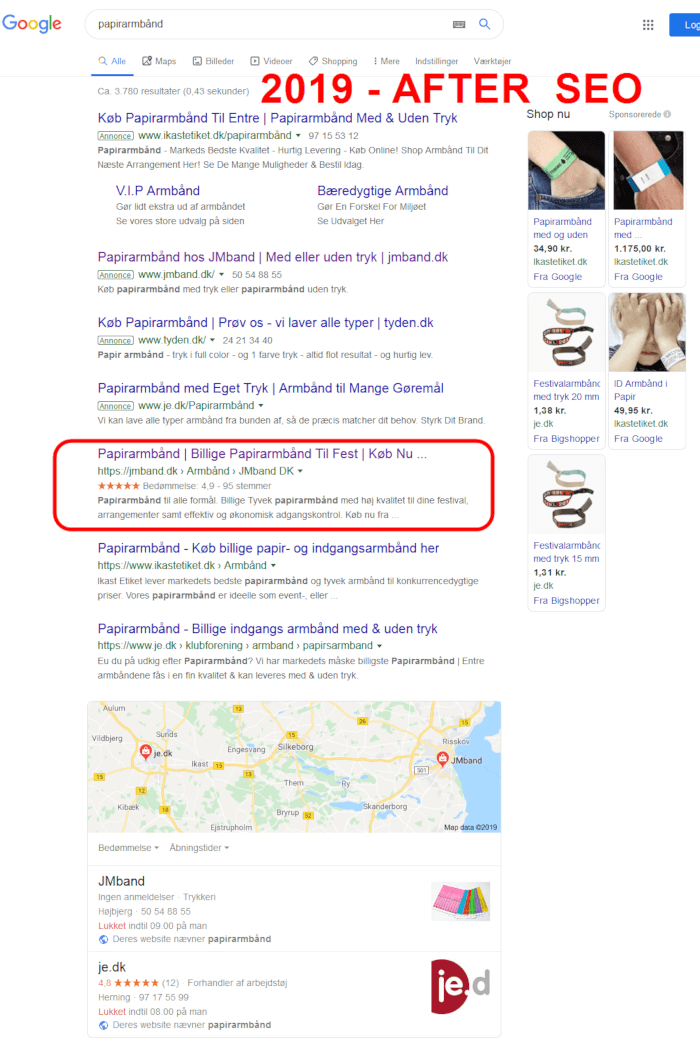
Hreflang Issues
Another important issue for companies that that target multiple countries and languages using several websites is the proper use of hreflang tags. Hreflang tags are to be used on a page basis and NOT on a domain basis. You have the list ALL the alternate URLs for all language and country combinations corresponding to the displayed page.
Wrong Implementation of Hreflang Tags
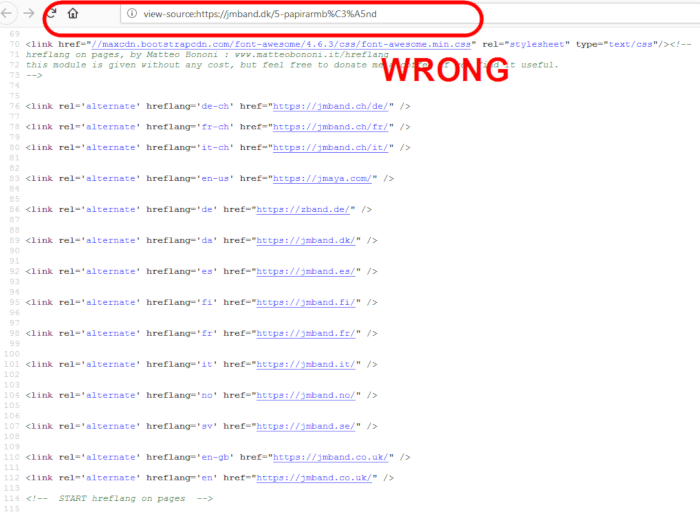
Correct Implementation of Hreflang Tags
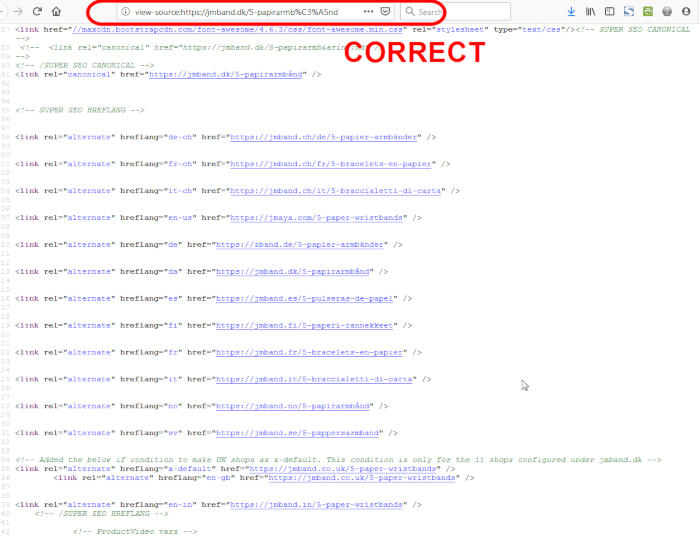
Wrong Redirects
The websites was configured to resolve to a non-www version of the websites. However due to wrong configuration all the www versions of any secondary store domain were getting resolved to the default or the primary domain i.e. jmband.dk.
This was happening as for a Prestashop multi-store, you have to create two URLs for each store: one with the "www.", one without it!
For instance: http://www.jmband.co.uk/ and http://jmband.co.uk/
Otherwise, customers trying to access any secondary store with the "www." in the URL will be redirected to the main store i.e. jmband.dk. This was exactly the situation that was happening and we corrected it.
Wrong Redirects - www.jmband.co.uk Redirects to Wrong Website
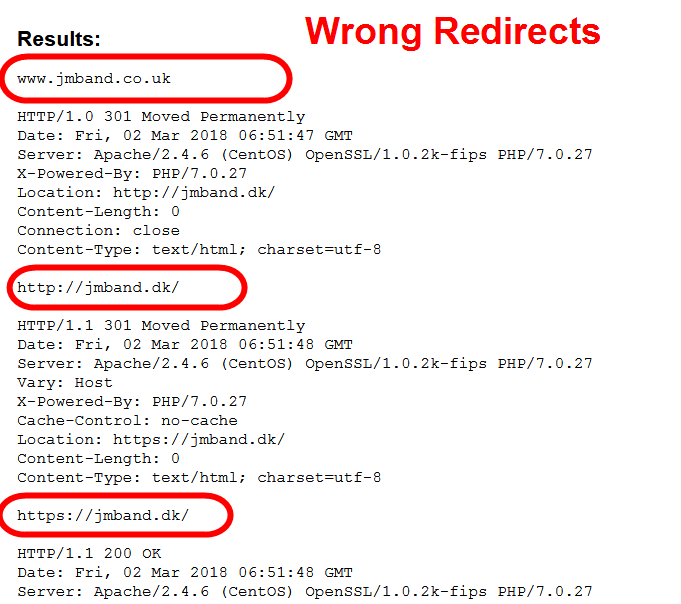
Another consequence of wrong redirects is that the wrong website gets indexed.
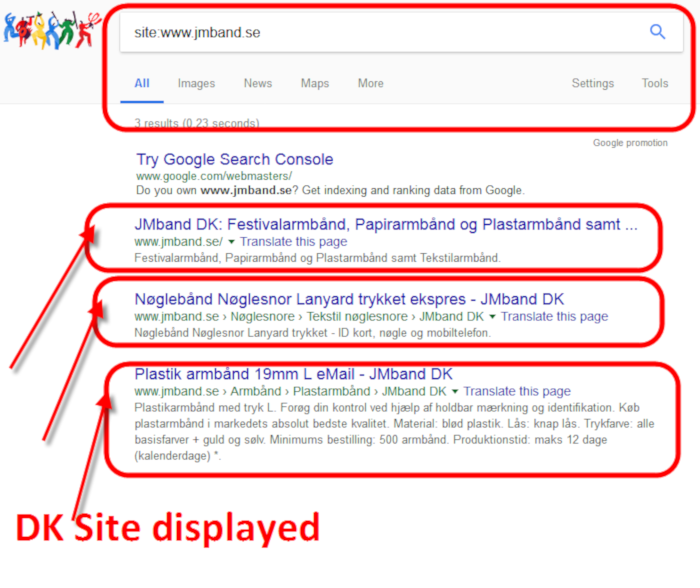
The corrected redirects are shown below.
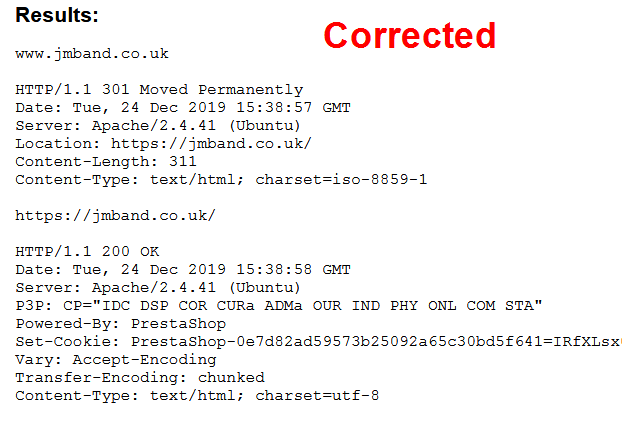
Language Parameters
The content of the Italian website is displayed on the Danish site if a language parameter is attached. This happens for all the secondary websites (Domains). Further this content if indexed causes the Danish website to appear in the Italian search results and not the Italian website. Thus duplicate content issues are created on a large scale.
For example https://jmband.dk/?id_lang=16 has to be 301 redirected to https://jmband.dk or a canonical tag has to be inserted.
Please click to enlarge the screenshot.
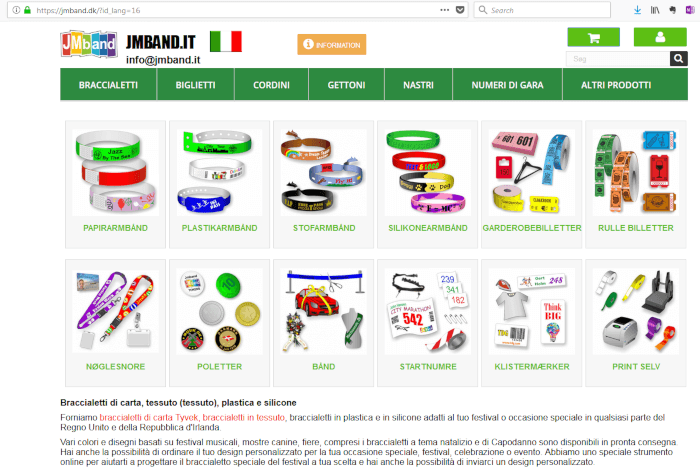
A further problem is caused when the wrong website appears in the search results. Below, the Danish website started appearing in the Italian search results.
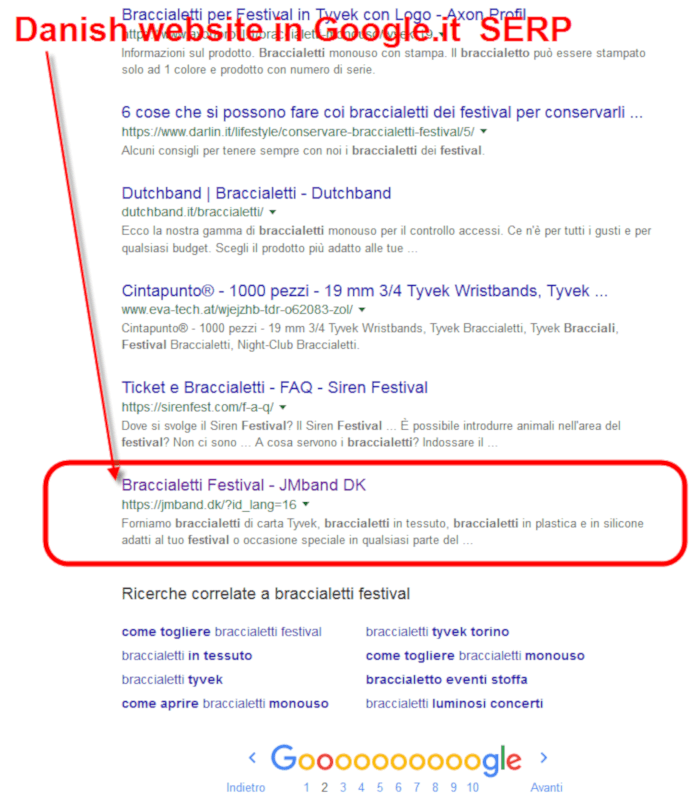
Sitemap Errors
The essential point to note when creating a sitemap is that you only enter urls that you want indexed - NOT THOSE that result in 404 or are blocked by robots.txt. Lots of URLS were included that result in 404 pages or were blocked by robots.txt.
Wrongly Created Sitemap
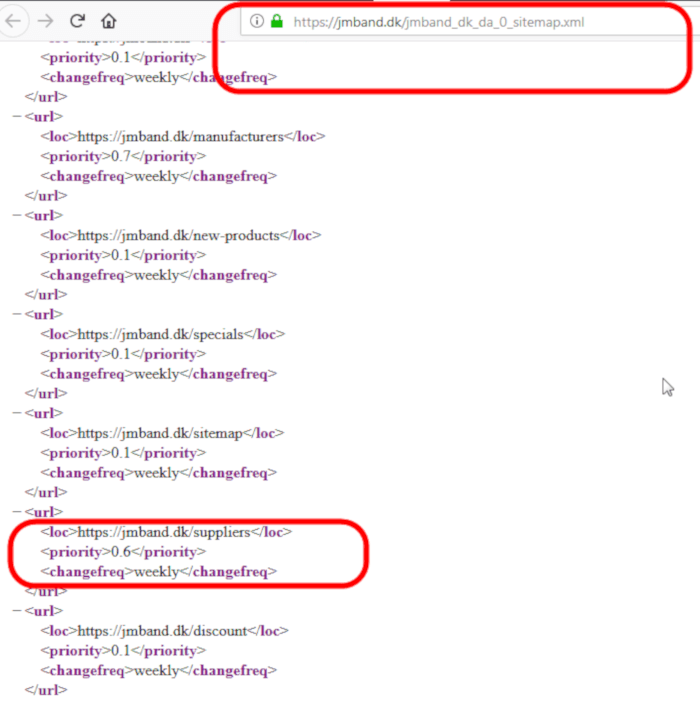
Test Subdomains Indexed
Several test Subdomains created on the website were indexed resulting in duplicate content. This takes place as they were not blocked. If a domain is required for testing, it is always necessary to use noindex, nofollow for the meta robots text.
An example is shown below.
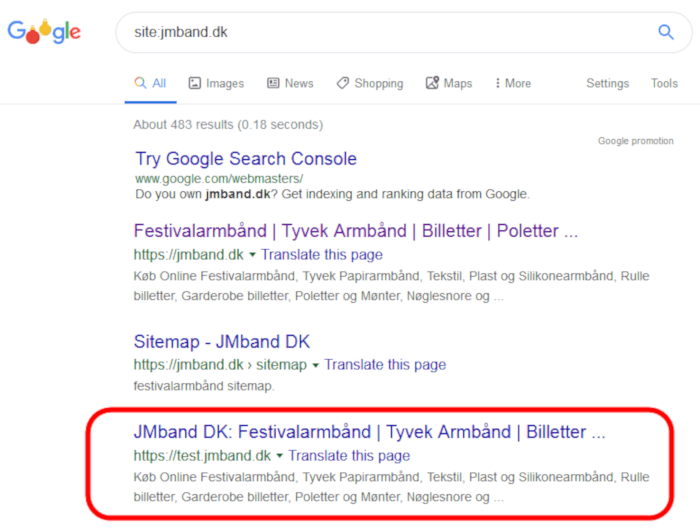
Why Did the Test Subdomains get Indexed?
The meta robots tag was index, follow as shown below.
Now to rectify such an issue use noindex, nofollow for the meta robots text and wait till Google recrawls the entire test subdomain. Do not delete the test subdomain.This is because sometimes deleting subdomains that are indexed can show as 5XX errors and confuse Google.
Please click to enlarge.
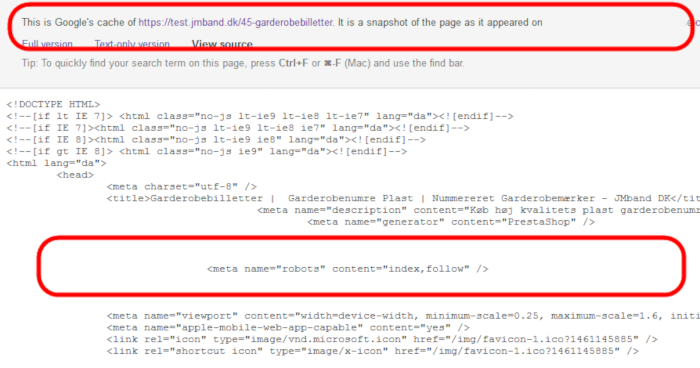
Duplicate Content Issues
Another way duplicate content was being generated was the parameter content_only=1 because of the option to display the content in a thickbox with just the content and without any header and footer of the website. Such an option confuses the search engines and they do not know which page to display.
I have already seen an unrelated e-commerce site lose traffic on a massive scale when the print friendly page was also indexed and I corrected it by adding noindex, nofollow to the print friendly version of the page.
For example
https://jmband.dk/content/7-Garanti and the duplicate https://jmband.dk/content/7-Garanti?content_only=1
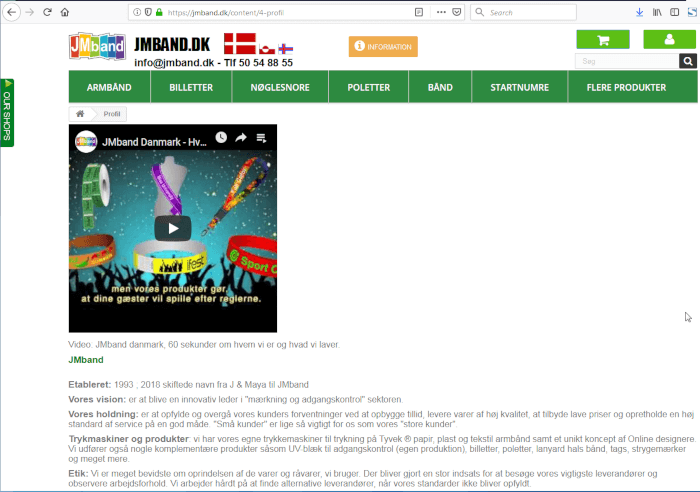
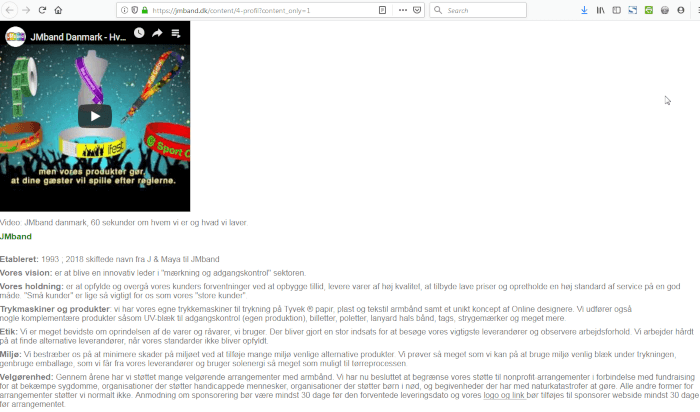
You have to enter the preferred url as canonical in the header of BOTH the webpages in case you want to retain
the two URLs. Here both the URLS were as canonicals - Which is WRONG - USE ONLY ONE AS CANONICAL.
Google has clearly stated the following regarding duplicate URLs: "If you don't explicitly tell Google which URL is canonical, Google will make the choice for you, or might consider them both of equal weight, which might lead to unwanted behavior"
H Tags, Page Speed and Unsecure Pages
H Tags
H2 or any other H tags for that matter should NOT be used in the menu. Avoid using heading tags to resize text. Instead, use the CSS font-size property. You must always style menus with custom CSS. This can be accomplished by changing code in template or Menu Module.
H tags (<h1> to <h6> tags) are used to indicate their relative importance. <h1> defines the most important HTML heading and <h6> defines the least important heading. The must be only one <h1> tag.
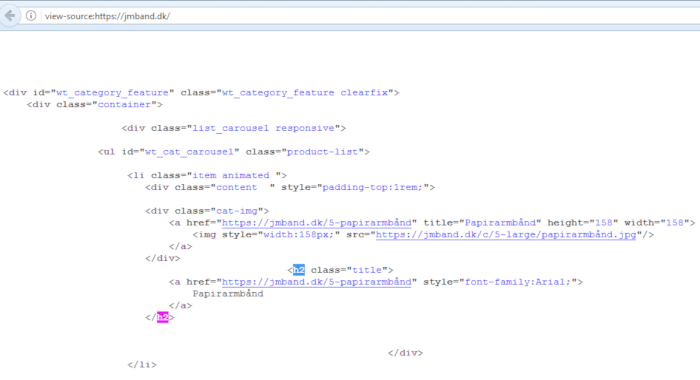
Page Speed
Studies have demonstrated that as page load times go up, the chance of someone leaving your website increases dramatically.
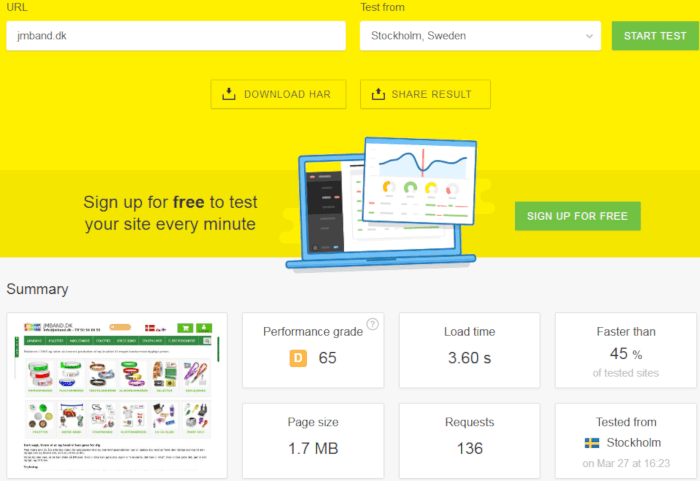
Finding Unsecure Pages or Subdomains
A quick overview of unsecure pages and subdomains that are indexed by Google was obtained by using this search operator: site:jmband.dk -inurl:https
You can get a similar overview for any website by replacing jmband.dk with your domain.
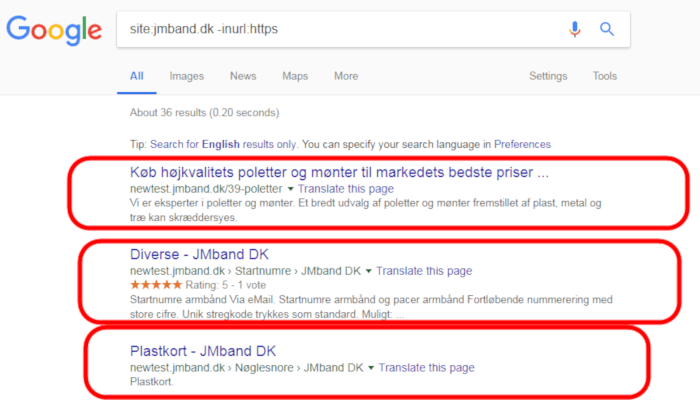
Thin Content
Many extremely thin content pages had got indexed by Google. noindex, follow was used in the robots meta tag in the head of the page to get them deindexed.
In general noindex thin content pages like listing of manufacturers, login pages, pages for loggedin customers, and in general pages that have very little value. Some are marked below in red.
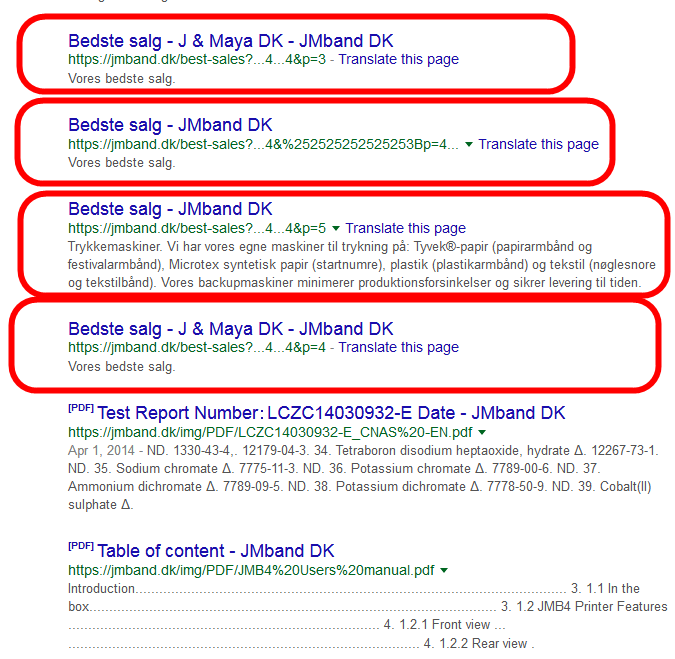
Title and Meta Description Tags
The Title Tags and Meta Description tags
Title Tags were rewritten as per the keywords targeted and the content on the page for the home page and six other pages for the Danish and UK websites.
Since the content was too little lots of additional content was written as discussed earlier.
As Google and most search engines do not use Metakeywords tag at all, no changes were done.
Danish SEO Case Study Checklist
- Detailed Keyword Research.
- Revising The Content.
- Introduction Video Explaining The Products Supplied.
- Solving Keyword Cannibalisation Issues
- Correcting Hreflang Issues
- Correcting Redirects
- Correcting Sitemap Errors
- Solving Language Parameters Related Duplicate content Issues
- Deindexing Test Subdomains that were Indexed
- Solving Duplicate Content Issues due to Display Parameters
- Optimising H Tags
- Checking Page Speed
- Finding Unsecure Pages or Subdomains
- Noindexing Thin Content
- Optimising Title and Meta Description Tags for the home page and six other pages for the Danish and UK websites
About The Author
Joseph de Souza is a leading Freelance SEO consultant and Web developer in Goa, India with more than 18 years of experience in internet marketing.
He has a proven track record and has has helped several companies increase their traffic many times over and thereby increase their revenue and profits.
Besides English, Joseph has also successfully optimized two German language websites and a Danish language website and obtained outstanding results.
